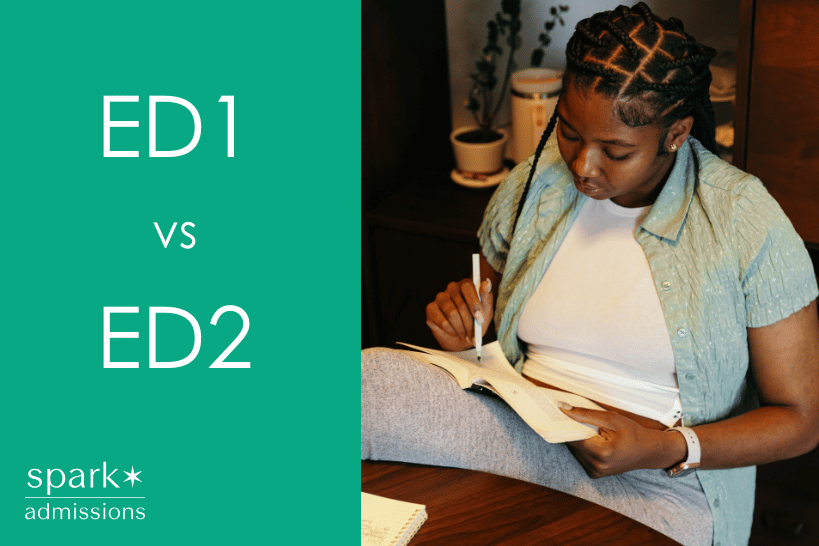- Blog
- > College Admissions
Early Decision 1 vs. Early Decision 2
- Dr. Rachel Rubin
- | September 14, 2025

Applying to college is a complex and often stressful journey for high school students, and one of the most strategic decisions revolves around the choice between Early Decision 1 (ED1) and Early Decision 2 (ED2). Both options allow students to apply early to their top choice, but each carries unique advantages, timelines, and commitments. Understanding these differences can improve your college applications and help you navigate the college admissions process effectively.

What Is Early Decision 1?
Early Decision 1 is the original binding application option offered by many selective colleges and universities. Students applying ED1 typically submit their college applications in early November of their senior year, and they receive an admission decision in mid-December.
Because ED1 applicants are signaling their strong commitment to a particular school, admissions offices often favor these applications. The acceptance rates for ED1 can be significantly higher than Regular Decision for competitive schools such as Ivy League institutions, Johns Hopkins University, and Vanderbilt University.
Applying ED1 is ideal for students who have a clear top-choice school and are confident that it is the best fit academically, socially, and financially. Since ED1 is a binding commitment, students are expected to enroll if admitted, and financial aid packages (or the lack thereof) must be carefully considered before applying.
Understanding Early Decision 2
Early Decision 2 (ED2) offers students a second chance to apply Early Decision if they were not ready to commit in the fall. ED2 applications are generally submitted in early January, with decisions released in late February or early March.
While ED2 is still a binding agreement, it provides additional time for students to improve their test scores, strengthen letters of recommendation, and polish their application materials. ED2 can be particularly useful for high school seniors who need to retake the SAT or ACT, update their academic achievements, or clarify financial aid needs–or for those who were not admitted to their ED1 school.
Because ED2 applicants often apply later in the cycle, acceptance rates can be slightly lower than ED1, but this depends on the school and the size of the ED1 applicant pool. For students with a strong application strategy, ED2 remains a valuable option to secure admission to a top choice.
Binding Commitment: What It Means for Students
One of the most important distinctions of both ED1 and ED2 is the binding commitment. Unlike Early Action or Regular Decision, ED applicants are required to attend the school if accepted.
This binding agreement impacts your college application journey in several ways:
- Students must ensure they can meet financial needs if admitted, even if the school offers them no aid.
- Changing your mind after acceptance is not an option unless there is an extreme circumstance, which could have consequences with the school’s admissions offices.
- The commitment can demonstrate a serious interest to colleges, potentially increasing the likelihood of acceptance.
Comparing Acceptance Rates: ED1, ED2, and Regular Decision
One of the main questions for applicants is how ED1 and ED2 acceptance rates compare to Regular Decision.
ED1: Historically, ED1 applicants enjoy the highest acceptance rates at selective schools. This is largely because ED1 applicants tend to have higher test scores, stronger grades, and more compelling extracurricular activities. Schools also use ED1 to secure a portion of their incoming class early, helping with yield rates.
ED2: ED2 provides a second opportunity for admission, but the pool may differ from ED1. While the acceptance rate may be slightly lower, applicants have additional time to strengthen application components such as personal statements and recommendation letters.
Regular Decision: RD applicants generally face stiffer competition, as many top students have already applied ED1 or ED2. Regular admission rates can be lower than Early Decision rounds, particularly for highly selective schools and popular programs.
Key Differences Between ED1 and ED2
The most obvious difference between ED1 and ED2 is timing. ED1 requires early November submission with mid-December notification, while ED2 is typically submitted in early January with decisions released later in the spring.
Another difference lies in the preparation period. ED1 applicants often rely on materials completed during their junior year, such as test scores, transcripts, and extracurricular records. In contrast, ED2 applicants have the advantage of a few extra months in senior year to improve their academic performance, retake the SAT or ACT, and polish application components like personal statements or letters of recommendation.
Because both ED1 and ED2 are binding agreements, students must carefully assess financial aid needs and be certain they are ready to commit to their top-choice college. This binding nature can also influence admissions officers’ decisions, as schools value applicants who demonstrate genuine interest and commitment.
Strategic Considerations for ED1 vs. ED2
Deciding whether to apply ED1 or ED2 requires a thoughtful approach:
- Know Your Top Choice: ED1 is best for students with a clear first choice, whereas ED2 is suited for those needing additional preparation or clarity.
- Evaluate Financial Aid Needs: Since both ED1 and ED2 are binding commitments, students must ensure that they can afford tuition or are satisfied with the financial aid package.
- Consider Academic Readiness: If a student plans to retake standardized test scores or improve their GPA, ED2 provides extra time to strengthen the application.
- Assess Application Components: Strong letters of recommendation, a polished personal statement, and meaningful extracurricular activities can improve your chances of admission, especially in ED2.
- Understand School Policies: Some institutions limit the number of ED2 spots or have a more competitive pool, so researching admissions trends and statistics is essential.
Early Action vs. Early Decision
While exploring ED1 and ED2, some students may also consider Early Action (EA). Unlike ED, EA is non-binding, allowing students to apply early and receive admission decisions without a commitment to enroll. EA offers flexibility in comparing financial aid packages and other top-choice schools.
For students who are not ready to commit but want an early head start on the college admissions process, EA can be an effective strategy. However, students should weigh acceptance rates and institutional preferences, as some selective schools prioritize ED applicants.
Maximizing Your Chances of Admission
Applying ED1 or ED2 can give students a strategic advantage in the college admissions process, but success depends on several factors:
- Academic Preparation: Strong grades, rigorous high school coursework, and impressive test scores are critical.
- Extracurricular Excellence: Admissions officers value well-rounded applicants who demonstrate leadership and meaningful engagement.
- Personal Statement and Recommendations: Crafting compelling essays and obtaining insightful letters of recommendation are essential for competitive schools.
- Application Strategy: Working with a school counselor or admissions expert can help determine whether ED1, ED2, or Regular Decision best fits your profile.
Conclusion
Understanding the differences between Early Decision 1 and Early Decision 2 is essential for high school students navigating the college admissions process. ED1 is ideal for students ready to commit to a top choice, offering earlier notification and often higher acceptance rates. ED2 serves as a second chance for applicants needing additional time to strengthen their test scores, plan around financial aid, or complete other components of their college applications.
Both ED1 and ED2 are binding commitments, so careful consideration of financial aid, academic readiness, and overall fit is critical. For students seeking flexibility or additional time to compare top schools, Regular Decision and Early Action remain viable alternatives.
At Spark Admissions, we guide students through every step of the college application process. From determining whether ED1 or ED2 is the right strategy to optimizing application materials and strengthening your overall profile, we help students develop the skills and strategy to maximize their chances of admission at selective schools.
Schedule a free consultation with Spark Admissions today to explore your early application options, refine your strategy, and take confident steps toward your college goals.





